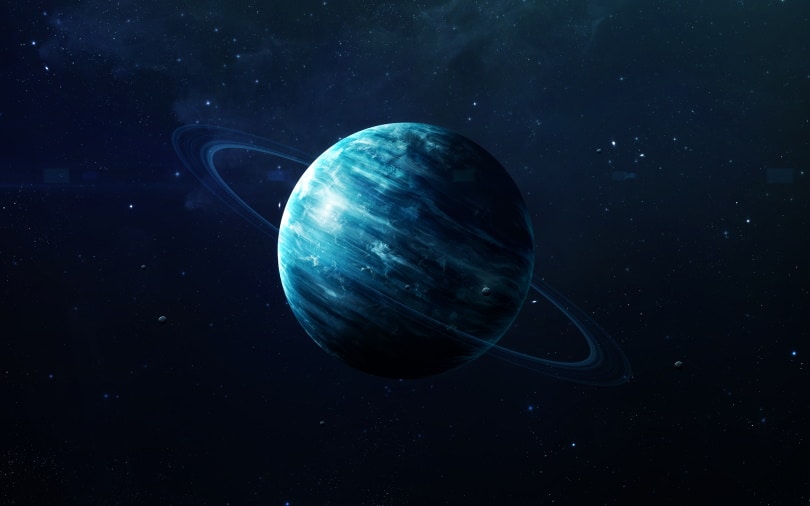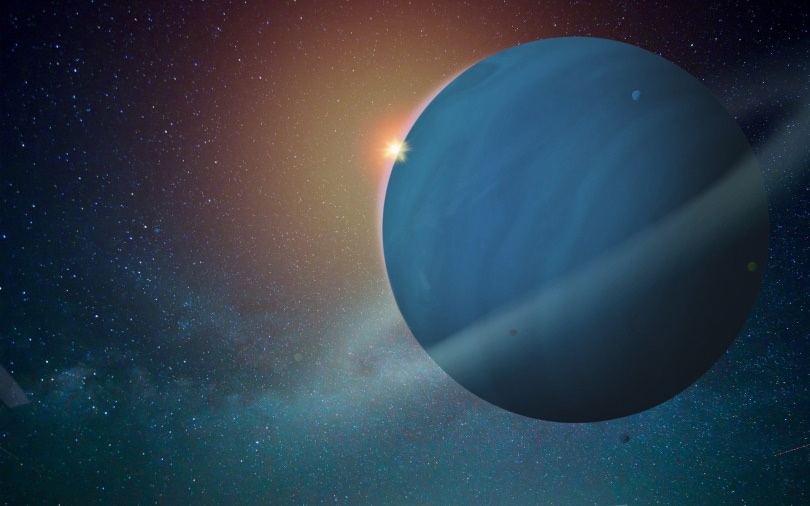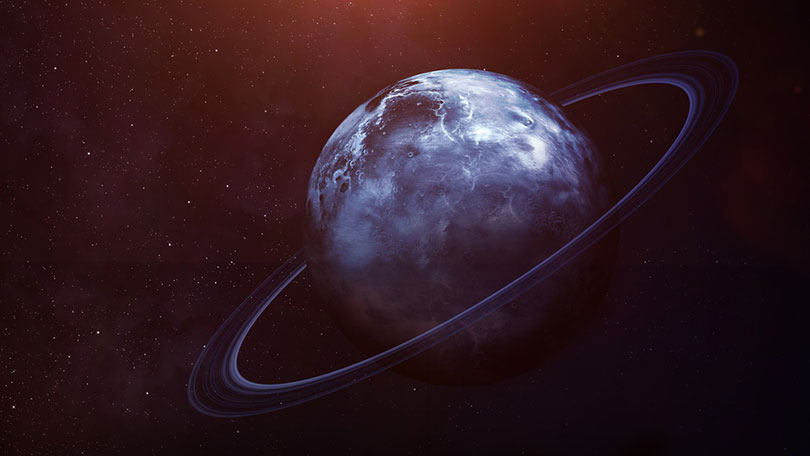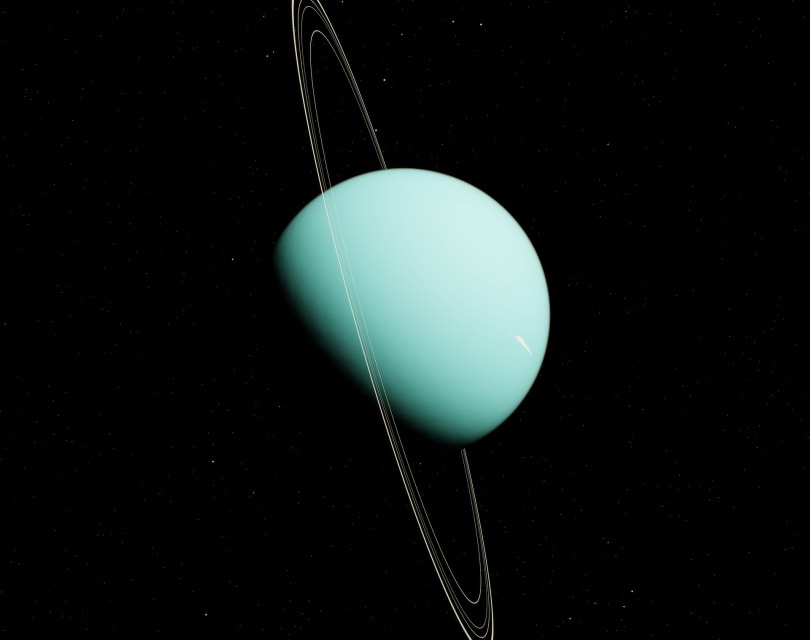How Long Is a Day on Uranus? How Long Is a Year?
Last Updated on

The seventh planet in our solar system, Uranus, is significantly larger than Earth and much further away from the sun. That distance and size have an interesting effect on the length of a year on Uranus and the length of a day as well.
To better understand why you need to know how a planet’s day and year are calculated. A day is calculated by measuring the time it takes a planet to spin (rotate) one time on its axis. A year is calculated by measuring the time it takes that same planet to go completely around the sun one time.
In the case of Uranus, it takes 17.14 hours for this gas giant to spin one time on its axis. That means a Uranian day is 17.14 hours long, and a year on Uranus is almost 84 earth years (30,660 days). It’s also worth noting that the speed Uranus travels is just under 15,300 miles per hour (24,600 kilometers per hour).

How Many Hours Is a Day on Uranus?
As we mentioned earlier, it takes Uranus 17 hours and 14 minutes to spin on its axis. That means a Uranian day is 17.14 hours long, about 7 hours less than Earth. Although Uranus spins faster than Earth, it actually spins backward. This means that while Earth and the other planets spin from west to east, Uranus spins east to west. This backward spinning motion is known as a retrograde rotation. Of all the planets, only Uranus and Venus share this uncommon trait. In other words, if you were to stand on Uranus (which as we’ll see is next to impossible) you would see the sun come up in the west and go down in the east.

Why Is Uranus’ Year so Long?
The reason the year on Uranus is nearly 84 years (30,660 days) long is that it’s so much further from the sun than the Earth. While the Earth is about 93 million miles (151 million kilometers) from the sun, Uranus is about 1.9 billion miles (3 billion kilometers) away. Since a planet’s year is calculated by how long it takes to go around the sun one time, it makes sense that, being much further away, Uranus takes much longer than Earth to do so.
If you’re a fan of very technical details, it’s worth pointing out that, at its farthest distance from the sun (called the aphelion), Uranus is 1,89 billion miles (3 billion kilometers) away. However, at its closest distance to the sun (the perihelion), Uranus is 1.7 billion miles (2,5 billion kilometers) away. The reason for this discrepancy is the elliptical orbit of Uranus, which is more of an oval than a circle.
How Long Is a Day on Uranus vs. Earth?
As we learned earlier, a planet’s day is calculated by how long it takes to spin on its axis for one full rotation. Even though it’s significantly larger than Earth, Uranus spins much faster. Earth, for example, spins at about 1,000 mph (1610 kph), whereas Uranus spins at 15,300 mph (24,600 kph), which is much faster. These differences in speed mean that it takes the Earth 24 hours to make one full rotation, while Uranus only needs about 17 hours.

How Long Would It Take To Get to Uranus from Earth?
Scientists have calculated that it would take humans between 12 and 15 years to get from Earth to Uranus in a spacecraft. For comparison, the Voyager 2 exploratory spacecraft, which was launched on August 20th, 1977, finally made it to Uranus on January 24th, 1986. That means it took almost 9 1/2 years to make the journey. However, Voyager 2 was unmanned, which meant it could travel faster. A manned spacecraft, due to various reasons, would need to travel slower and thus would take longer.
What Would Happen If You Fell Into Uranus?
Falling into the atmosphere and down to the surface of Uranus would be a bad day for any human. First, you would need a spacesuit to protect you from the incredibly cold temperatures of about -224 degrees Fahrenheit. The view would be spectacular if you could survive, but, currently, there aren’t any spacesuits that can withstand such frigid cold.
If, however, you had a space suit that protected you and allowed you to smell the atmosphere, it would disgust you. That’s because Uranus’ atmosphere is filled with hydrogen sulfide gas, which has a potent stench.
As you fall further, the temperature would increase dramatically, and so would the pressure. In fact, the pressure is so strong that scientists believe it compresses carbon atoms into diamonds! Many have surmised that Uranus has “diamond rain” for this very reason, although this hasn’t been confirmed.
If you managed to make it to the surface in one piece without melting, being crushed, or being turned into a diamond, the view at night would be superb. Uranus has 27 moons, and some of which you would (possibly) see through the thick clouds of methane and other gases.

How Old a Planet Is Uranus?
Our solar system was formed approximately 4.6 billion years ago. For that reason, Uranus and the rest of the planets surrounding our sun are about 4.6 billion years old. Of course, that’s just a scientific “best guess.”
How Strong Is the Gravity on Uranus?
One very interesting fact about Uranus is that, even though it is significantly larger than Earth, the gravity on the planet’s surface is less than Earth’s. Indeed, it’s 14% less, which means that if you weighed 200 pounds (91 kilograms) on Earth, you would weigh 172 pounds (78 kilograms) on Uranus. However, when you consider that the “surface” of Uranus is mostly fluids and gases, finding somewhere to stand and measure your weight would be difficult.

What Is the Atmosphere Like on Uranus?
The atmosphere on Uranus is much different from Earth. While Earth’s atmosphere is 78% nitrogen, 21% oxygen, and 1% other gases, the atmosphere on Uranus is mostly hydrogen and helium. It also has small amounts of methane and trace amounts of ammonia and water. Interestingly, the gases in the atmosphere of Uranus give it its signature bluish color.
More significantly, the winds on the surface of Uranus reach speeds of nearly 560 mph (900 kph). When you consider that a Category 5 hurricane on Earth has winds of 157 mph (252 kph) or higher, just standing in one place on Uranus without being blown away would be next to impossible.
- See also: What Color Is Uranus? What Are True & False Colors?
- Song Sparrow: Field Guide, Pictures, Habitat & Info

Final Thoughts
Congratulations, you now know more about Uranus than most of your friends and family! You know, for example, that a day on Uranus is 17 hours and 14 minutes while a Uranian year takes 84 Earth years to pass. We hope you enjoyed these facts and figures about Uranus! If you did, please be sure to share this article and let others in on the wonders of our gas-giant neighbor in space, Uranus!
See also:
- 10 Interesting Facts About Mars
- How Many Moons Does Mars Have?
- How Many Rings Does Jupiter Have?
- How Big is Uranus?
Featured Image Credit: Vadim Sadovski, Shutterstock
Table of Contents
- How Many Hours Is a Day on Uranus?
- Why Is Uranus’ Year so Long?
- How Long Is a Day on Uranus vs. Earth?
- How Long Would It Take To Get to Uranus from Earth?
- What Would Happen If You Fell Into Uranus?
- How Old a Planet Is Uranus?
- How Strong Is the Gravity on Uranus?
- What Is the Atmosphere Like on Uranus?
- Final Thoughts
About the Author Robert Sparks
Robert’s obsession with all things optical started early in life, when his optician father would bring home prototypes for Robert to play with. Nowadays, Robert is dedicated to helping others find the right optics for their needs. His hobbies include astronomy, astrophysics, and model building. Originally from Newark, NJ, he resides in Santa Fe, New Mexico, where the nighttime skies are filled with glittering stars.
Related Articles:
How to Collimate Binoculars: 9 Expert Tips
Binocular Magnification Chart: Numbers & Distances Compared
How to Clean a Refractor Telescope: Step-by-Step Guide
How to Clean a Telescope Eyepiece: Step-by-Step Guide
What Is the Best Binocular Magnification for Hunting? Optical Features Explained
How to Clean a Rifle Scope: 8 Expert Tips
When Were Binoculars Invented? History, Today & Future
Can You Use Binoculars to Look At Stars? How to Choose the Right Pair
